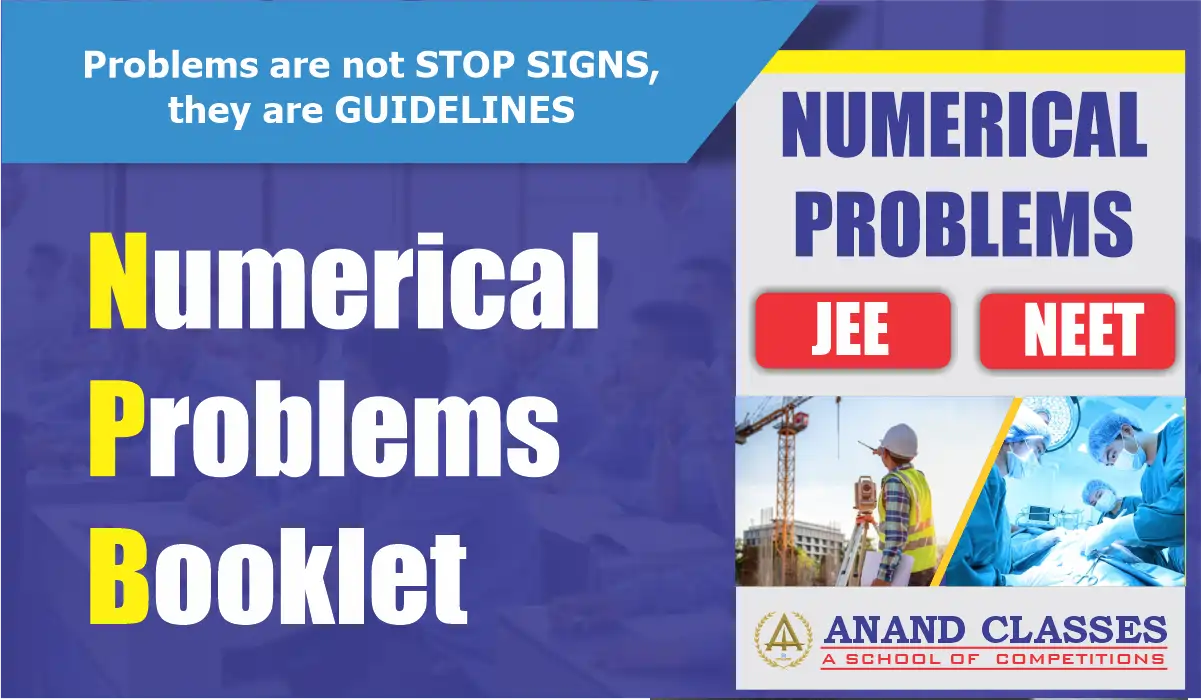Magnetic Effects of Current Notes With JEE NEET MCQS Physics Class 12 CBSE Study Material Full Chapter Download pdf-Anand Classes
Magnetic Effect of Electric Current – A magnetic field is a force field that is created by magnetic dipoles and moving electric charges, and it exerts a force on other nearby moving charges and magnetic dipoles. Magnetic Field is a vector quantity because it has both magnitude and direction.
Magnetic Field Lines
A magnetic field line or lines of forces shows the strength of a magnet and the direction of a magnet’s force. It was discovered by Michael Faraday to visualise the magnetic field.
Direction of Field Lines
Magnetic field lines are directed from the south pole to the north pole inside the magnet and from the north pole to the south outside the magnet.
Strength of Magnetic Field Lines
A straight current-carrying conductor has a magnetic field in the shape of concentric circles around it. Magnetic field lines can visualise the magnetic field of a straight current-carrying conductor.
The direction of a magnetic field produced due to a current-carrying conductor relies upon the same direction in which the current is flowing.
The direction of the magnetic field gets reversed if the direction of the electric current changes.
Suppose a straight current-carrying conductor is hung vertically, and an electric current is flowing from north to south, i.e. from up to down. In this situation, the direction of the magnetic field will be clockwise. And if the same current is flowing from south to north through the same conductor, the direction of the magnetic field will be anti-clockwise.
Magnetic Effect of Electric Current Notes PDF
The direction of the magnetic field in electric current through a straight conductor can be represented by using the Right-Hand Thumb Rule.
Right-Hand Thumb rule
Assume that you are holding a straight current-carrying conductor in your right hand such that the thumb points towards the direction of the current. Then your fingers will wrap around the conductor in the direction of the magnetic field lines.
The Right-Hand Thumb rule is also known as Maxwell’s corkscrew rule. If we consider ourselves driving a corkscrew in the current direction, then the corkscrew’s direction is in the direction of the magnetic field.
Magnetic Field Due to Flow of Current through a Circular Loop
The magnetic field produced in a circular current carrying conductor is the same as that of the magnetic field due to a straight current-carrying conductor and the current-carrying circular loop will behave like a magnet.
The magnetic field lines in a current-carrying circular loop would be in the shape of concentric circles, and at the centre of the circular wire, field lines will become straight and perpendicular to the plane of the coil.
The direction of the magnetic field in a circular loop can be recognised using the Right-Hand Thumb Rule.
Magnetic Field Due to Flow of Current in a Solenoid
A solenoid is a tightly wound helical coil of wire whose diameter is smaller than its length.
he magnetic field produced by the current-carrying solenoid is similar to a bar magnet. The magnetic field produced inside a solenoid is parallel which is similar to a bar magnet. One solenoid end behaves as a south pole, and the other end behaves as a north pole.
The strong magnetic force produced by a solenoid can be used to magnetize a piece of magnetic material. The magnet so formed is known as an electromagnet.
Direct Current
- Direct Current is the unidirectional flow of electric current. The flow of current does not change periodically. In the case of direct current, the current flows in a single direction at a steady voltage.
- Direct current power is widely used in low voltage applications such as charging batteries and light aircraft electrical systems.
- A direct current can be obtained from an alternating current using a rectifier. A rectifier contains electronic elements or electromechanical elements that allow current to flow only in one direction.
- Direct current can also be converted into alternating current using a motor-generator set or an inverter.
- The direction of the magnetic field in electric current through a straight conductor can be represented by using Right-Hand Thumb Rule.
1. Define magnetic field lines.
Michael Faraday invented magnetic field lines to see the magnetic field. A magnetic field line, also known as a force line, represents the strength and direction of a magnet’s force.
2. What is the strength of the magnetic field line?
A magnetic field in concentric circles surrounds a straight current-carrying conductor. Magnetic field lines can describe the magnetic field of a current-carrying straight wire. The current direction represents the direction of a magnetic field developed by a current-carrying conductor.
When the direction of the electric current varies, the magnetic field switches.
3. What is the direction of field lines?
The magnetic field lines of magnets are directed from the north pole to the south pole and from the south pole to the north outside the magnet.
4. State and explain the right-hand thumb rule.
Suppose you were holding a straight current-carrying conductor in your right hand, and your thumb indicates the current direction. Now wrap your finger around the conductor, so here the direction of your fingers will be the direction of the magnetic field lines. The right-hand thumb rule is also known as Maxwell’s corkscrew rule.
5. State Fleming’s right-hand rule.
Suppose you arrange your right-hand thumb, middle finger, and forefinger perpendicularly. In that case, your thumb will indicate the magnetic force’s direction, the middle finger will point in the current’s direction, and the forefinger will point in the magnetic field’s direction; this is the statement of Fleming’s right-hand rule.
6. Why don’t two magnetic lines of force intersect?
The resulting force on a north pole at every point can only be in one direction, which is why the magnetic lines of force do not intersect. However, if the two magnetic lines of force intersect, the resultant force on a north pole placed at the point of intersection can be in the opposite direction, which is not possible.
7. Define the term electromotive force.
The motion of a magnet about the coil causes an induced potential difference. This induced potential difference is known as electromotive force, and it causes an induced electric current to flow in the circuit. An induced potential difference is produced when a magnet moves towards a coil.
8. What is a solenoid?
A solenoid is an instrument made up of a coil of wire. A solenoid can be used as an electromagnet.
9. What is the significance of the current magnetic effect?
The magnetic effect of electric current is one of the essential effects of electric current in use, without which we would not be able to have motors in the modern world. A current-carrying conductor generates a magnetic field that can be visualised using force or magnetic field lines.
10. Write a brief note on the direct current.
A motor-generator set or an inverter can also be used to convert direct current to alternating current. Direct current power is typically used in low-voltage applications like battery charging and light aircraft electrical systems. The unidirectional flow of electric current is known as direct current. The current in direct current flows in a single direction at a constant voltage. The flow of current does not alter regularly. A rectifier is used to convert alternating current to direct current. A rectifier comprises electrical or electromechanical components that allow current to flow solely in one direction.
Frequently Asked Questions – FAQs
State Fleming’s right-hand rule.
State Fleming’s left-hand rule.
What would be the shape of the magnetic field lines in a circular current carrying loop?
State Right Hand Thumb Rule.
Assume that you are holding a straight current-carrying conductor in your right hand such that the thumb points towards the direction of the current. Then your fingers will wrap around the conductor in the direction of field lines of the magnetic field.The Right-Hand Thumb rule is also known as Maxwell’s corkscrew rule. If we consider ourselves driving a corkscrew in the current direction, then the corkscrew’s direction is in the direction of the magnetic field.
What is the direction of Magnetic field lines?
magnetic effect of electric current worksheet pdf, what is the magnetic effect of electricity, what do you mean by magnetic effect of electricity, magnetic effect of electric current class 10 worksheet pdf download, what is the magnetic effect of electricity, effects of electric current pdf, what do you mean by magnetic effect of electricity, magnetic effects of electric current worksheet, magnetic effect of electric current class 10 worksheet pdf, what is the magnetic effect of electricity, what do you mean by magnetic effect of electricity, magnetic effects of electric current worksheet, what is magnetic effect of current electricity, magnetic effect of electric current worksheet pdf, what is the magnetic effect of electricity, what do you mean by magnetic effect of electricity, magnetic effects of electric current worksheet, effects of electric current pdf,


















